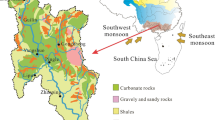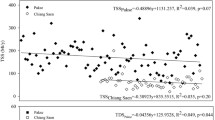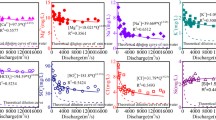Abstract
Climate and environmental changes are having profound impacts on Arctic river basins, but the biogeochemical response remains poorly understood. To examine the effect of ice formation on temporal variations in composition and fluxes of carbon and nutrient species, monthly water and particulate samples collected from the lower Yukon River between July 2004 and September 2005 were measured for concentrations of organic and inorganic C, N, and P, dissolved silicate (Si(OH)4), and stable isotope composition (δD and δ18O). All organic carbon and nutrient species had the highest concentration during spring freshet and the lowest during the winter season under the ice, indicating dominant sources from snowmelt and flushing of soils in the drainage basin. In contrast, inorganic species such as dissolved inorganic carbon (DIC) and Si(OH)4 had the highest concentrations in winter and the lowest during spring freshet, suggesting dilution during snowmelt and sources from groundwater and leaching/weathering of mineral layer. The contrasting relation with discharge between organic, such as dissolved organic carbon (DOC), and inorganic, such as DIC and Si(OH)4, indicates hydrological control of solute concentration but different sources and transport mechanisms for organic and inorganic carbon and nutrient species. Concentration of DOC also shows an inter-annual variability with higher DOC in 2005 (higher stream flow) than 2004 (lower stream flow). Average inorganic N/P molar ratio was 110 ± 124, with up to 442 under the ice and 38–70 during the ice-open season. While dissolved organic matter had a higher C/N ratio under the ice (45–62), the particulate C/N ratio was lower during winter (21–26) and spring freshet (19). Apparent fractionation factors of C, N, P, Si and δD and δ18O between ice and river water varied considerably, with high values for inorganic species such as DIC and Si(OH)4 (45 and 9550, respectively) but lower values for DOC (4.7). River ice formation may result in fractionation of inorganic and organic solutes and the repartitioning of seasonal flux of carbon and nutrient species. Annual export flux from the Yukon River basin was 1.6 × 1012 g-DOC, 4.4 × 1012 g-DIC, and 0.89 × 1012 g-POC during 2004–2005. Flux estimation without spring freshet sampling results in considerable underestimation for organic species but significant overestimation for inorganic species regardless of the flux estimation methods used. Without time-series sampling that includes frozen season, an over- or under-estimation in carbon and nutrient fluxes will occur depending on chemical species. Large differences in carbon export fluxes between studies and sampling years indicate that intensive sampling together with long-term observations are needed to determine the response of the Yukon River to a changing climate.







Similar content being viewed by others
References
Aagaard K, Carmack EC (1989) The role of sea ice and other fresh water in the Arctic circulation. J Geophys Res 94:14485–14498
Balcarczyk KL, Jones JB, Jaffe R, Maie N (2009) Stream dissolved organic matter bioavailability and composition in watersheds underlain with discontinuous permafrost. Biogeochemistry 94:255–270
Belzile C, Guo L (2006) Optical properties of low molecular weight and colloidal organic matter: application of the ultrafiltration permeation model to DOM absorption and fluorescence. Mar Chem 98:183–196
Belzile C, Gibson JAE, Vincent WF (2002) CDOM and DOC exclusion from lake ice: implications for irradiance transmission and carbon cycling. Limnol Oceanogr 45:1283–1293
Benner R, Benitez-Nelson B, Kaiser K, Amon RMW (2004) Export of young terrigenous dissolved organic carbon from rivers to the Arctic Ocean. Geophys Res Lett 31:L05305. doi:10.1029/2003GL019251
Brabets TP, Wang B, Meade RH (2000) Environmental and hydrological overview of the Yukon River Basin, Alaska and Canada. USGS Water-Resources Investigations Report 99-4204
Broecker WS, Peng TH (1982) Tracers in the sea. Eldigio Press, Palisades, New York
Cai Y, Guo LD (2009) Abundance and variation of colloidal organic phosphorus in riverine, estuarine and coastal waters in the northern Gulf of Mexico. Limnol Oceanogr 54:1393–1402
Cai Y, Guo LD, Douglas TA (2008a) Temporal variation in organic carbon species and fluxes from the Chena River, Alaska. Limnol Oceanogr 53:1408–1489
Cai Y, Guo LD, Douglas TA, Whitledge TE (2008b) Seasonal variations in nutrient concentrations and speciation in the Chena River, Alaska. J Geophys Res 113:G030035. doi:10.1029/2008JG000733
Cooper LW, McClelland JW, Holmes RM, Raymond PA, Gibson JJ, Guay CK, Peterson BJ (2008) Flow-weighted values of runoff tracers (δ18O, DOC, Ba, alkalinity) from the six largest Arctic rivers. Geophys Res Lett 35:L18606. doi:10.1029/2008GL035007
Dornblaser MM, Striegl RG (2007) Nutrient (N, P) loads and yields at multiple scales and subbasin types in the Yukon River basin, Alaska. JGR 112:G04S57
Finlay J, Neff J, Zimov S, Davydova A, Davydov S (2006) Snowmelt dominance of DOC in high-latitude watersheds: implications for characterization and flux of river DOC. Geophys Res Lett 33, art no. l10401
Frey KE, McClelland JW (2009) Impacts of permafrost degradation on arctic river biogeochemistry. Hydrol Process 23:169–182
Frey KE, Smith LC (2005) Amplified carbon release from vast west Siberian peatlands by 2100. Geophys Res Lett 32(9):109401. doi:1029/2004GL022025
Grasshoff K, Kremling K, Ehrhardt M (1999) Methods of seawater analysis. Wiley-VCH, New York
Guéguen C, Guo LD, Wang D, Tanaka N, Hung C (2006) Chemical characteristics and origin of dissolved organic matter in the Yukon River. Biogeochemistry 77:139–155
Guéguen C, Guo LD, Yamamoto-Kawai M, Tanaka N (2007) Colored dissolved organic matter dynamics across the shelf/basin interfaces in the western Arctic Ocean. J Geophys Res 112(C05):C05038. doi:10.1029/2006JC003584
Guo LD, Macdonald RW (2006) Sources and transport of terrigenous organic matter in the upper Yukon River: evidence from isotope (13C, 14C and 15N) composition of dissolved, colloidal and particulate phases. Glob Biogeochem Cycl 20:GB2011. doi:10.1029/2005GB002593
Guo LD, Santschi PH, Warnken KW (1995) Dynamics of dissolved organic carbon in oceanic environments. Limnol Oceanogr 40:1392–1403
Guo LD, Zhang JZ, Guéguen C (2004a) Speciation and fluxes of nutrients (N, P, Si) from the upper Yukon River. Glob Biogeochem Cycl 18(1):GB1038. doi:10.1029/2003GB2152
Guo LD, Semiletov I, Gustafsson O, Ingri J, Andersson P, Dudarev O, White D (2004b) Characterization of Siberian Arctic estuarine sediments: implications for terrestrial organic carbon export. Glob Biogeochem Cycl 18:GB1036. doi:10.1029/2003GB002087
Guo LD, Ping CL, Macdonald RW (2007) Mobilization pathways of organic carbon from permafrost to Arctic rivers in a changing climate. Geophys Res Lett 34:L13603. doi:10.1029/2007GL030689
Hinzman LD, Bettez ND et al (2005) Evidence and implications of recent climate change in northern Alaska and Arctic regions. Clim Change 72:251–298
Holmes RM, McClelland JW, Peterson BJ, Shiklomanov IA, Shiklomanov AI, Zhulidov AV, Gordeev VV, Bobrovitskaya NN (2002) A circumpolar perspective on fluvial sediment flux to the Arctic Ocean. Glob Biogeochem Cycl 16:1098. doi:10.1029/2001GB001849
Hope D, Billett MF, Cresser MS (1994) A review of the export of carbon in river water: fluxes and processes. Environ Pollut 84:301–324
Jorgenson MT, Shur YL, Pullman ER (2006) Abrupt increase in permafrost degradation in Arctic Alaska. Geophys Res Lett 33:L02503
Leenheer L (1982) United States Geological Survey data information service. In: Degens ET (ed) Transport of carbon and minerals in major world rivers, vol 52. SCOPE/UNEP Sonderband, Hamburg, pp 355–356
Lobbes JM, Fitznar HP, Kattner G (2000) Biogeochemical characteristics of dissolved and particulate organic matter in the Russian rivers entering the Arctic Ocean. Geochim Cosmochim Acta 64:2973–2983
Macdonald RW, Paton DW, Carmack EC, Omstedt A (1995) The freshwater budget and under-ice spreading of Mackenzie River water in the Canadian Beaufort Sea based on salinity and 18O/16O measurements in water and ice. J Geophys Res 100(C1):895–919
Mayer TD, Jarrell WM (1995) Assessing colloidal forms of phosphorus and iron in the Tualatin-river basin. J Environ Qual 24:1117–1124
McClelland JW et al (2008) Development of a pan-Arctic database for river chemistry. EOS Trans AGU 89:217–218
McGuire AD, Anderson L, Christensen TR, Dallimore S, Guo LD, Hayes D, Heimann M, Macdonald RW, Roulet N (2009) Sensitivity of the carbon cycle in the Arctic to climate change. Ecol Monogr 79:523–555
Michaelson GJ, Ping CL, Kimble JM (1996) Carbon storage and distribution in tundra soils of Arctic Alaska, USA. Arct Alp Res 28(4):414–424
Peterson BJ, Holmes RM, McClelland JW, Vorosmarty CJ, Shiklomanov IA, Shiklomanov AI, Lammers RB, Rahmstorf S (2002) Increasing river discharge to the Arctic Ocean. Science 298:2171–2173
Petrone KC, Jones JB, Hinzman LD, Boone RD (2006) Seasonal export of carbon, nitrogen, and major solutes from Alaskan catchments with discontinuous permafrost. JGR 111(G2), Art. no. G02020
Ping CL, Michaelson GJ, Jorgenson MT, Kimble JM, Epstein H, Romanovsky VE, Walker DA (2008) High stocks of soil organic carbon in the North American Arctic region. Nat Geosci 1:615–619. doi:10.1038/ngeo284
Raymond PA, McClelland JW, Holmes RM, Zhulidov AV, Mull K, Peterson BJ, Striegl RG, Aiken GR, Gurtovaya TY (2007) Flux and age of dissolved organic carbon exported to the Arctic Ocean: a carbon isotopic study of the five largest arctic rivers. Glob Biogeochem Cycl 21:GB4011. doi:10.1029/2007GB002934
Rember RD, Trefry JH (2004) Increased concentrations of dissolved trace metals and organic carbon during snowmelt in rivers of the Alaskan Arctic. Geochim Cosmochim Acta 48:477–489
Schuster PF (2003) Water and sediment quality in the Yukon River Basin, Alaska during water year 2001. U.S. Geological Survey, Open-File Report, 03-427
Serreze MC, Maslanik JA, Scambos TA, Fetterer F, Stroeve J, Knowles K, Fowler C, Drobot S, Barry RG, Barry RG, Haran TM (2003) A record minimum arctic sea extent and area in 2002. Geophys Res Lett 30:1110. doi:10.1029/2002GL016406
Smith LC, Sheng Y, MacDonald GM, Hinzman LD (2005) Disappearing Arctic lakes. Science 308:1429–1430
Solorzano C, Sharp J (1980) Determination of total dissolved phosphorus and particulate phosphorus in natural waters. Limnol Oceanogr 25:754–758
Spencer RGM, Aiken GR, Wickland KP, Striegl RG, Hernes PJ (2008) Seasonal and spatial variability in dissolved organic matter quantity and composition from the Yukon River basin, Alaska. Glob Biogeochem Cycl 22:GB4002
Spencer RGM, Aiken GR, Butler KD, Dornblaser MM, Striegl RG, Hernes PJ (2009) Utilizing chromophoric dissolved organic matter measurements to derive export and reactivity of dissolved organic carbon exported to the Arctic Ocean: a case study of the Yukon River, Alaska. Geophys Res Lett 36:L06401
Stein R, Macdonald RW (2004) The organic carbon cycle in the Arctic Ocean. Springer, New York
Striegl RG, Aiken GR, Dornblaser MM, Raymond PA, Wickland KP (2005) A decrease in discharge-normalized DOC export by the Yukon River during summer through autumn. Geophys Res Lett 32(21):L21413
Striegl RG, Dornblaser MM, Aiken GR, Wichland KP, Raymond PA (2007) Carbon export and cycling by the Yukon, Tanana, and Porcupine rivers, Alaska, 2001–2005. Water Resour Res 43:W02411. doi:10.1029/2006WR005201
Walvoord MA, Striegl RG (2007) Increased groundwater to stream discharge from permafrost thawing in the Yukon River basin: potential impacts on lateral export of carbon and nitrogen. Geophys Res Lett 34(12):L12402
Warnken KW, Santschi PH (2004) Biogeochemical behavior of organic carbon in the Trinity River downstream of a large reservoir lake in Texas, USA. Sci Total Environ 329:131–144
Worrall F, Burt TP (2007) Flux of dissolved organic carbon from UK rivers. Glob Biogeochem Cycl 21:GB1013
Xu CH, Guo LD, Dou F, Ping CL (2009) Potential DOC production from size fractionated Arctic Tundra soils, Alaska. Cold Reg Sci Technol 55:141–150. doi:10.1016/j.coldregions.2008.08.001
Zou L, Sun MY, Guo L (2006) Temporal variations of organic carbon inputs into the upper Yukon River: evidence from fatty acids and their stable carbon isotopic composition in dissolved, colloidal and particulate phases. Org Geochem 37(8):944–956
Acknowledgments
We gratefully thank Chunhao Xu, Mindy Juliana, Peter deHard, Toru Saito (UAF), Lloyd Heckman (Pilot Station, AK), and Mike Parker (Alaska Fish and Game) for sampling assistance, Diana Flosenzier for critical reading of the manuscript, Associate Editor, Eran Hood, and two anonymous reviewers for constructive comments. This work was supported in part by the National Science Foundation (NSF-EAR#0554781, ARC#0436179, and OCE#0850957), the Frontier Research System for Global Change/Japan through the International Arctic Research Center at the University of Alaska Fairbanks, the Northern Gulf Institute, and the University of Southern Mississippi.
Author information
Authors and Affiliations
Corresponding author
Rights and permissions
About this article
Cite this article
Guo, L., Cai, Y., Belzile, C. et al. Sources and export fluxes of inorganic and organic carbon and nutrient species from the seasonally ice-covered Yukon River. Biogeochemistry 107, 187–206 (2012). https://doi.org/10.1007/s10533-010-9545-z
Received:
Accepted:
Published:
Issue Date:
DOI: https://doi.org/10.1007/s10533-010-9545-z




